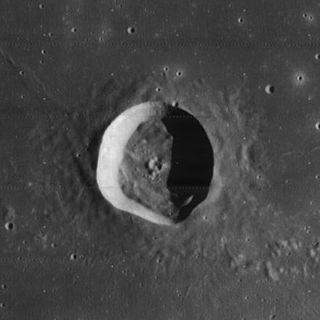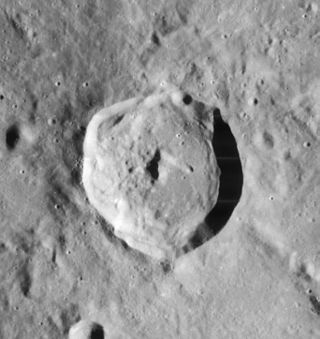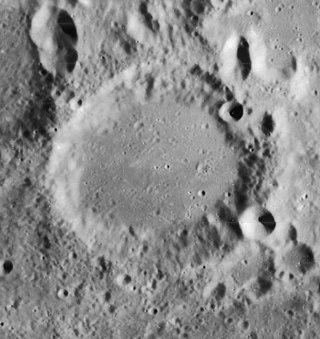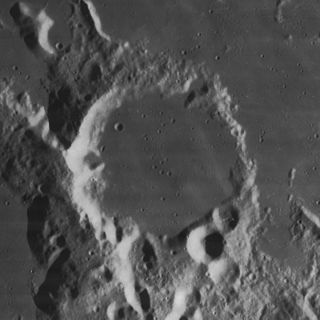
Flamsteed is a small lunar impact crater located on the Oceanus Procellarum, which is named after British astronomer John Flamsteed. It lies almost due east of the dark-hued Grimaldi, and north-northwest of the flooded Letronne bay on the south edge of the mare.

Agrippa is a lunar impact crater that is located at the southeast edge of the Mare Vaporum. It is located to the north of the crater Godin, the irregular Tempel lies just to the east. To the north and northeast, the rille designated Rima Ariadaeus follows a course to the east-southeast, reaching the western edge of Mare Tranquillitatis. It is named after the 1st century Greek astronomer Agrippa.

Apianus is a lunar impact crater that is located on the rugged south-central highlands of the Moon. It is named after 16th century German mathematician and astronomer Petrus Apianus. It is located to the northeast of the crater Aliacensis, and to the northwest of Poisson. The worn crater Krusenstern is attached to the west-northwestern rim.

Babcock is a lunar impact crater that is located on the far side of the Moon. It was named after American astronomer Harold D. Babcock. It lies on the northeastern edge of Mare Smythii, to the southeast of Mare Marginis. To the south of Babcock is the crater Purkynĕ, and to the east-northeast lies Erro. Babcock is located in a region of the Moon's surface that is occasionally brought into view during favorable librations, although it is seen from the edge and so little detail can be discerned from an observer on the Earth.

Biela is a lunar impact crater that is located in the rugged highlands of the southeastern Moon. It is named after Austrian astronomer Wilhelm von Biela. The crater lies to the east of Rosenberger, to the southeast of the Watt–Steinheil double crater.

Deluc is a lunar impact crater that lies in the southern highlands of the Moon. It is located to the south-southeast of the crater Maginus, and the huge Clavius. Due east of Deluc is the somewhat larger crater Lilius. It is 47 kilometers in diameter and 3.3 kilometers deep. It is from the Pre-Imbrian period, which lasted from 4.55 to 3.85 billion years ago.

Banachiewicz is a largely degraded lunar impact crater that is located near the eastern limb of the Moon.

Campanus is a lunar impact crater that is located on the southwestern edge of Mare Nubium. It was named after Italian astronomer Campanus of Novara. It forms a crater pair with Mercator just to the southeast. Along the southern rampart of Campanus is the small lunar mare named Palus Epidemiarum. To the southwest is the small crater Dunthorne.

Capuanus is a lunar impact crater that lies along the southern edge of the Palus Epidemiarum. It was named after Italian astronomer F. Capuano di Manfredonia. The outer rim is eroded and indented by lesser crater impacts, with notches in the north, west, and southern parts of the rim. The interior floor has been resurfaced by basaltic lava, which is connected to the surrounding lunar mare by a narrow, crater-formed gap in the northern rim. Dotting the floor of the crater are a number of domes, which are believed to have formed through volcanic activity.

Elger is a lunar impact crater that lies along the southern edge of Palus Epidemiarum, the Marsh of Epidemics, in the southwest part of the Moon's near side. To the northeast is the flooded crater Capuanus, and farther to the northwest is Ramsden.

Cichus is a lunar impact crater that lies in the southwestern part of the Moon, at the eastern edge of Palus Epidemiarum. Just to the northeast and nearly contacting the rim is the lava-flooded crater remnant Weiss. The crater is named after Italian astronomer Cecco d'Ascoli.

Chang Heng is a lunar impact crater that is located on the Moon's far side. It lies less than one crater diameter to the northeast of the walled plain Fleming. The rim of this crater is somewhat eroded, with a pair of small craters along the northern rim and tiny craters along the south and east edges. The interior floor contains a small, concentric crater that is about one third the diameter of Chang Heng. The crater is named after Chinese astronomer Zhang Heng.

Wilkins is a lunar impact crater that lies in the rugged highlands in the southeastern part of the Moon's near side. It is located to the southwest of the crater Pons and the long Rupes Altai scarp. Just to the southeast lies the larger crater Zagut, and to the north-northwest is the still-larger Sacrobosco. Wilkins is 57 kilometers in diameter.

Faye is a heavily eroded lunar impact crater in the rugged southern highlands of the Moon. It is named after French astronomer Hervé Faye. It is attached to the northeastern rim of the crater Delaunay, with Donati located just a few kilometers to the northeast. It forms part of a chain of craters of increasing size to the southwest that continues with La Caille and ends with the walled plain Purbach.

Fourier is a lunar impact crater that is located in the southwestern part of the Moon's near side, just to the southeast of the crater Vieta. To the northeast is the Mare Humorum. The rim of this crater is roughly circular, but appears oval when viewed from the Earth due to foreshortening.

Pontanus is a lunar impact crater that is located in the southern highlands of the Moon's near side. It lies approximately midway between the craters Sacrobosco to the north-northeast and Gemma Frisius to the south-southwest. It is 58 kilometers in diameter and 2,120 meters deep.

Weiss is a lunar impact crater along the southern edge of the Mare Nubium. It was named after Austrian astronomer Edmund Weiss. Nearly attached to the southwest rim is the crater Cichus, and Pitatus lies just over one crater diameter to the east-northeast. To the east-southeast lies the eroded Wurzelbauer.

Stiborius is a lunar impact crater that lies to the south-southwest of the crater Piccolomini, in the southeastern quadrant of the Moon's near side. To the south-southwest of Stiborius is the smaller Wöhler. Stiborius is 44 kilometers in diameter and 3.7 kilometers deep.

Kinau is a small, eroded lunar impact crater that is located in the low southern latitudes of the Moon. It lies to the southeast of the crater Jacobi, and about equally far to the north-northwest of Pentland. It is 42 kilometers in diameter and two kilometers deep. It may be from the Pre-Nectarian period, 4.55 to 3.85 billion years ago.

Evershed is a lunar impact crater on the far side of the Moon, named after the English solar astronomer John Evershed. It is located to the northeast of the larger crater Cockcroft, and to the north of the smaller Van den Bergh.





















